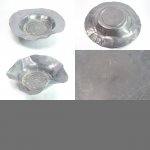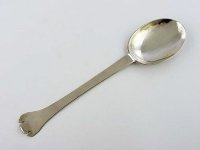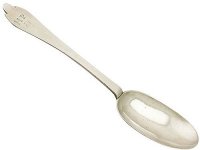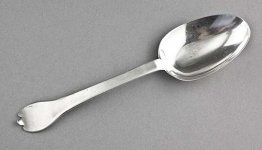You are using an out of date browser. It may not display this or other websites correctly.
You should upgrade or use an alternative browser.
You should upgrade or use an alternative browser.
Antique flexible pewter bowl and 1700s Trefid spoon?
- Jun 8, 2006
- 6,114
- 8,474
- Detector(s) used
- Whites, Minelab, Tesoro, and custom machines
- Primary Interest:
- Metal Detecting
Decorative base to hold a vase, maybe for flowers etc. I don't think it is flexible, just easy to bend ?
Upvote
0
To me, your 'bowl' looks to be made of stamped heavy aluminum rather than pewter. 
With the 'CHINA' mark, I'd say that it's a modern piece as opposed to 18thc.
It's definitely had a vase or something wet sitting in it.
Dave
With the 'CHINA' mark, I'd say that it's a modern piece as opposed to 18thc.
It's definitely had a vase or something wet sitting in it.
Dave
Upvote
0
"The word Trefid (or Trifid) means divided or split into three parts, which can be seen at the top of the handle and explains why it has this name. The handle is thickest nearer the bowl section of the spoon and becomes thinner as it reaches the upturned Trefid end. The spoon has had many variations; however the flat stem which gradually spreads to the upward turned Trefid end is the part of the spoon which has remained the same throughout its life. Although, the spread of the terminal moved downward towards the bowl at around 1700s and became more elaborate with decoration and some were even gilded.
Back in the 16th century you would generally have one spoon which you would use at all mealtimes and wash in-between uses, unlike the current day where it is normal to have a full set of cutlery in a household. It was also deemed a sign of class if your spoon was made from anything other than wood, let alone if you have one at all. It is suggested that silver spoons came to Britain with the Romans however, the Trefid spoon originated in France; the French call it ‘Pied de Biche’ which translated means Deer’s foot. It is said that Charles II while in court in France noticed they used a specific type of spoon called the Trefid and this was how it was introduced to Britain in 1660. Trefids are termed ‘the French Fashion Spoons’ and the style spread very quickly throughout the United Kingdom; in part due to the British people who took their old spoons to the silversmiths to have it melted and made into the new Trefid style."
Here are some examples of 17th & 18thc Trefid Spoons.
Dave
Back in the 16th century you would generally have one spoon which you would use at all mealtimes and wash in-between uses, unlike the current day where it is normal to have a full set of cutlery in a household. It was also deemed a sign of class if your spoon was made from anything other than wood, let alone if you have one at all. It is suggested that silver spoons came to Britain with the Romans however, the Trefid spoon originated in France; the French call it ‘Pied de Biche’ which translated means Deer’s foot. It is said that Charles II while in court in France noticed they used a specific type of spoon called the Trefid and this was how it was introduced to Britain in 1660. Trefids are termed ‘the French Fashion Spoons’ and the style spread very quickly throughout the United Kingdom; in part due to the British people who took their old spoons to the silversmiths to have it melted and made into the new Trefid style."
Here are some examples of 17th & 18thc Trefid Spoons.

Dave
Attachments
Upvote
0
2into4
Tenderfoot
- Thread starter
- #7
I was hoping you may be able to have a look at it and possibly know more about it. It is in this forum at http://www.treasurenet.com/forums/what/591130-1700s-trefid-spoon-bm-hallmark-please-help.html
Upvote
0
Users who are viewing this thread
Total: 2 (members: 0, guests: 2)








